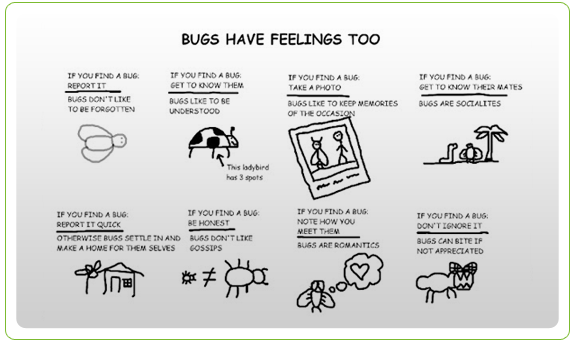
ORIGINAL IMAGE BY – Andy Glover
It may sound funny, but it is the truth. As testers, we should know how to properly deal with bugs so they can be mitigated on the development process accurately and swiftly. Let’s take a look on the items below as I try to expound each item illustrated on the photo:
- If you find a bug, report it. Bugs don’t like to be forgotten.Bugs that were evident on the development process and left forgotten can mutate into something worse (maybe in the form of intermittent bugs, system-wide occurring bug) which needs complex code fix – whilst this little bug can still be fixed earlier on. And if these little bugs reach the customer’s production or live systems, read #8. One can avoid this by simply reporting this bug right away after the discovery.
- If you find a bug, get to know them. Bugs like to be understood.Getting to know how bugs work, how they manifest, how they look like, how they are replicated et cetera are essential when reporting a bug. Everybody wants to read a complete bug report, be it a coder, a co-tester, or someone from the higher ups.
- If you find a bug, take a photo. Bugs like to keep memories of the occasion.Screenshots. Whenever there’s a manifestation of a bug, always hit that print screen key for you to have strong evidence when reporting a bug occurrence. On addition to this, you can take videos of the actual occurrence of the bug including the steps on how to replicate this. This is very useful especially when reporting intermittent bugs.
- If you find a bug, get to know their mates. Bugs are socialites.Since web pages are interconnected at some point, a bug that was spotted on a certain field, pop-up, frame or webpage can be evident on other parts of the system as well. You might pay those pages a visit too, to see if they are also affected by the bug. Another instance for this could be the occurrence of a bug that is product of another bug. If you are successful on finding the root bug in the application, it might help your coder a lot.
- If you find a bug, report it quick. Otherwise bugs settle in and make a home for themselves.If a bug was left unfixed, the code where it resides can be used on new features – especially if other developers don’t know that there’s a bug existing on that code. If this process is reiterated, the scale of the bug can increase dramatically. As much as possible, try to report a bug the moment you’ve found a bug.
- If you find a bug, be honest. Bugs don’t like gossips.Creating unjustifiable hype on your bug reports is a big no for you as a tester. You’ll just help to dip your teammates’ trust ratings on you if you try to do this all the time. Report the bug exactly the way it is – no more, no less. It might be worth noting, but please don’t try to sugar coat or be wordy on your bug reports. Bug reports should be clean, straight-forward and accurate.
- If you find a bug, note how you meet them. Bugs are romantics.Illustrating the step by step procedure on how you replicated the bug will help all possible readers of your bug reports to know how you’ve encountered the bug hence, they can replicate the issue quickly.
- If you find a bug, don’t ignore it. Bugs can bite if not appreciated.Bugs are costly in resources when it reaches the production or live builds. Aside from possible tongue-lashing you’ll receive from the customers, the turn-around process repeats again. Evaluate – Code – Test – Deploy. So if you found a bug, don’t ever ignore it.
Note:
Be careful when reporting bugs right away. You should confirm the issues you’ve found to your superior to avoid things like duplicate bug entry on your bug log.
Happy testing!
Credits: Cartoontester Blog

